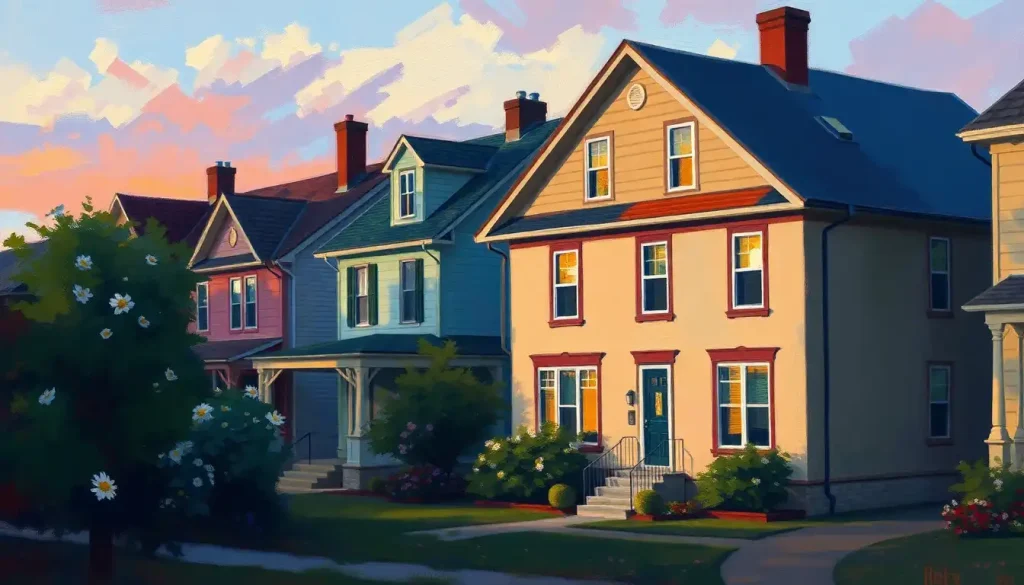House hunters across America are losing sleep over a number that’s causing widespread sticker shock: the daunting 7% mortgage interest rate that’s reshaping the real estate landscape. This seemingly innocuous figure has become a source of anxiety for many prospective homebuyers, leaving them wondering if their dreams of homeownership are slipping away. But before we dive into the nitty-gritty of what this means for you and your future abode, let’s take a step back and explore the bigger picture.
Interest rates are the silent puppeteers of the housing market, pulling strings that affect everything from home prices to buyer demand. They’re like the weather of the financial world – sometimes sunny and inviting, other times stormy and intimidating. Right now, we’re in the midst of what feels like a financial thunderstorm, with rates hovering around levels that many younger buyers have never experienced before.
The Current State of Mortgage Rates: A Rollercoaster Ride
If you’ve been keeping an eye on the mortgage market, you’ve probably noticed that rates have been on a wild ride lately. It’s like watching a high-stakes poker game where the stakes keep getting higher. The days of rock-bottom rates that we saw during the pandemic are long gone, replaced by a new reality that’s forcing many to recalibrate their homebuying plans.
But what’s driving this upward trend? Well, it’s a complex cocktail of economic factors, including inflation concerns, Federal Reserve policies, and overall economic health. These elements combine like ingredients in a potent financial brew, creating the market conditions we’re seeing today.
For first-time buyers, interest rates can be particularly daunting. It’s like being thrown into the deep end of the pool without water wings. Suddenly, that dream home you’ve been eyeing might seem just out of reach. But don’t throw in the towel just yet – understanding the implications of these rates is the first step in navigating this challenging market.
A Trip Down Memory Lane: Mortgage Rates Through the Years
To truly appreciate where we are now, we need to take a quick jaunt through history. Mortgage rates have had more ups and downs than a roller coaster at Six Flags. In the 1980s, rates soared to an eye-watering 18.63% – yes, you read that right. Imagine trying to buy a house with that kind of interest rate! It makes our current 7% seem almost quaint by comparison.
Fast forward to the early 2000s, and we saw rates hovering around 5-6%, which felt pretty reasonable at the time. Then came the 2008 financial crisis, which sent rates plummeting to historic lows. For a while, homebuyers were basking in the glow of sub-4% rates, thinking it would last forever. Spoiler alert: it didn’t.
Now, as we grapple with rates around 7%, it’s important to put things in perspective. While it might feel high compared to recent years, historically speaking, it’s not off the charts. It’s more like we’ve returned to a version of “normal” that we haven’t seen in a while.
The Million-Dollar Question: Is 7% Really That High?
So, is a 7% interest rate high for a house? Well, it’s not a simple yes or no answer. It’s more of a “it depends” situation. Compared to the rates we’ve been spoiled with in recent years, yes, 7% feels high. It’s like going from all-you-can-eat buffet prices back to à la carte dining. But in the grand scheme of things, it’s not astronomical.
Let’s break it down. A 7% rate will undoubtedly impact your monthly payments and the overall cost of your loan. For example, on a $300,000 30-year fixed-rate mortgage, the difference between a 4% rate and a 7% rate could mean paying an extra $500 or more per month. That’s not chump change – it could be the difference between affording that extra bedroom or settling for a smaller home.
However, whether 7% is “high” also depends on your individual circumstances. If you’re in a high-cost area like Utah, where housing interest rates might be particularly impactful due to elevated home prices, 7% could feel more burdensome. On the other hand, if you’re in a more affordable market or have a higher income, it might be more manageable.
The Good, the Bad, and the Ugly of a 7% Mortgage Rate
Now, let’s put on our objectivity hats and evaluate whether a 7% interest rate is actually good. Like most things in life, it’s not black and white – there are pros and cons to consider.
On the plus side, higher rates can sometimes lead to a cooling housing market, potentially bringing down inflated home prices. This could create opportunities for buyers who have been priced out of the market. Additionally, if you lock in a 7% rate now and rates continue to rise, you might find yourself feeling pretty smug down the line.
However, the downsides are pretty obvious. Higher rates mean higher monthly payments and more interest paid over the life of the loan. It’s like paying a premium for your slice of the American dream. For some, this might mean delaying homeownership or settling for less house than they initially hoped for.
When comparing to other financing options, a 7% mortgage rate might not look so bad. Owner-occupied interest rates are typically lower than those for investment properties, so if you’re planning to live in the home, you’re already at an advantage. And let’s not even get started on credit card interest rates – suddenly, 7% doesn’t seem so scary, does it?
Navigating the 7% Waters: Strategies for Savvy Homebuyers
If you’re facing the prospect of a 7% mortgage rate, don’t panic. There are strategies you can employ to make the best of the situation. First and foremost, don’t be afraid to shop around and negotiate with lenders. It’s like haggling at a flea market – you might be surprised at what deals you can uncover if you’re willing to put in the effort.
Exploring different loan types can also be beneficial. While 30-year fixed-rate mortgages are the most common, they’re not the only game in town. Adjustable-rate mortgages (ARMs) might offer lower initial rates, which could be advantageous if you’re not planning to stay in the home long-term. Just be sure you understand the risks involved.
Improving your credit score is another powerful tool in your arsenal. A higher credit score can often translate to a lower interest rate, potentially saving you thousands over the life of your loan. It’s like giving your financial profile a makeover – a little effort can go a long way.
Lastly, consider buying points to lower your rate. This involves paying an upfront fee to reduce your interest rate. While it requires more cash at closing, it could result in significant savings over time, especially if you plan to stay in the home for many years.
Crystal Ball Gazing: What’s Next for Mortgage Rates?
Predicting the future of mortgage rates is about as easy as predicting the weather a year from now – in other words, it’s not. However, we can look at expert opinions and economic indicators to get a sense of where things might be heading.
Many economists believe that we may see rates stabilize or even decrease slightly in the coming years, assuming inflation continues to cool and economic growth remains steady. However, it’s unlikely we’ll see a return to the ultra-low rates of the recent past anytime soon.
The housing market is likely to continue adjusting to these higher rates. We might see a slowdown in price growth or even some price corrections in certain markets. For buyers, this could mean more negotiating power and less competition, but also potentially stricter lending standards.
The Bottom Line: Is 7% the New Normal?
As we wrap up our deep dive into the world of 7% mortgage rates, let’s recap the key points. Is 7% high for a house? In the context of recent years, yes. Historically speaking? Not really. Is it good? That depends on your individual circumstances and the broader economic context.
The most important takeaway is this: don’t let a 7% interest rate automatically deter you from pursuing homeownership. While it’s certainly a factor to consider, it’s just one piece of the puzzle. Your financial situation, long-term goals, and local market conditions all play crucial roles in determining whether buying a home makes sense for you.
If you’re grappling with buying a house with high interest rates, remember that there are strategies you can employ to make it more manageable. From improving your credit score to exploring different loan options, you have more power than you might think.
Ultimately, the decision to buy a home is a personal one that goes beyond just the interest rate. It’s about finding a place to call your own, building equity, and creating a stable foundation for your future. While a 7% rate might not be ideal, it doesn’t necessarily make homeownership unattainable.
As you navigate these choppy financial waters, don’t hesitate to seek professional advice. A knowledgeable financial advisor or mortgage professional can help you understand your options and make the best decision for your unique situation. After all, buying a home is likely to be one of the biggest financial decisions you’ll ever make – it’s worth getting expert guidance.
Remember, the housing market, like all markets, is cyclical. What goes up must come down, and vice versa. While we can’t predict exactly what the future holds, we can be sure that change is the only constant. So whether you decide to take the plunge at 7% or wait for more favorable conditions, stay informed, be strategic, and keep your long-term goals in sight.
In the end, the question isn’t just whether 7% is high or good – it’s whether it aligns with your personal financial journey and homeownership dreams. And that, dear reader, is a question only you can answer.
References:
1. Freddie Mac. (2023). Primary Mortgage Market Survey. Retrieved from http://www.freddiemac.com/pmms/
2. National Association of Realtors. (2023). Existing Home Sales Statistics. Retrieved from https://www.nar.realtor/research-and-statistics/housing-statistics/existing-home-sales
3. Federal Reserve Bank of St. Louis. (2023). 30-Year Fixed Rate Mortgage Average in the United States. Retrieved from https://fred.stlouisfed.org/series/MORTGAGE30US
4. Consumer Financial Protection Bureau. (2023). Explore interest rates. Retrieved from https://www.consumerfinance.gov/owning-a-home/explore-rates/
5. Urban Institute. (2023). Housing Finance at a Glance: A Monthly Chartbook. Retrieved from https://www.urban.org/research/publication/housing-finance-glance-monthly-chartbook
6. Mortgage Bankers Association. (2023). Mortgage Finance Forecast. Retrieved from https://www.mba.org/news-and-research/research-and-economics/forecasts-and-commentary
7. S&P Global. (2023). S&P CoreLogic Case-Shiller Home Price Indices. Retrieved from https://www.spglobal.com/spdji/en/index-family/indicators/sp-corelogic-case-shiller/
8. Federal Housing Finance Agency. (2023). House Price Index. Retrieved from https://www.fhfa.gov/DataTools/Downloads/Pages/House-Price-Index.aspx
9. Board of Governors of the Federal Reserve System. (2023). Federal Reserve Economic Data. Retrieved from https://www.federalreserve.gov/data.htm
10. U.S. Department of Housing and Urban Development. (2023). Housing Market Indicators Monthly Update. Retrieved from https://www.huduser.gov/portal/ushmc/home.html












Would you like to add any comments? (optional)